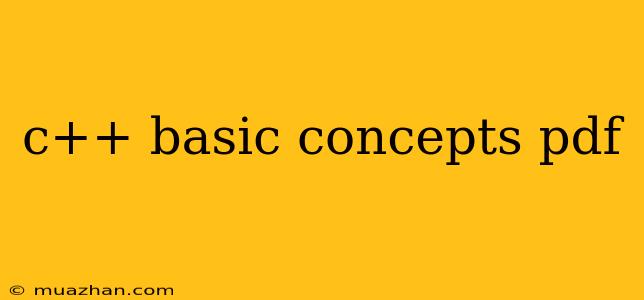C++ Basic Concepts PDF: A Comprehensive Guide
Learning C++ can be a rewarding journey, opening doors to various programming fields. This article will guide you through fundamental C++ concepts, providing a clear path for understanding this powerful language. While a PDF document might not be the perfect format for a complete guide, you can find various resources online to help you understand the basic concepts of C++.
Why C++?
C++ is a versatile language, known for its performance and control over system resources. Its use spans a wide range of applications, from game development and embedded systems to high-performance computing and operating systems. C++'s strengths lie in:
- Performance: C++ is renowned for its speed and efficiency, making it ideal for resource-intensive applications.
- Control: It allows direct manipulation of hardware and memory, giving developers fine-grained control over system resources.
- Object-Oriented: C++ supports object-oriented programming principles like encapsulation, inheritance, and polymorphism, promoting code organization and reusability.
- Legacy: C++'s strong foundation in C makes it compatible with existing C codebases, easing integration.
Essential C++ Concepts:
1. Variables and Data Types:
- Variables: Represent containers that store data.
- Data Types: Define the kind of data a variable can hold (e.g., int for integers, float for decimals, char for characters).
2. Operators:
- Arithmetic Operators: Perform mathematical operations (e.g., +, -, *, /).
- Relational Operators: Compare values (e.g., ==, !=, <, >).
- Logical Operators: Combine boolean expressions (e.g., &&, ||, !).
3. Control Flow:
- Conditional Statements (if-else): Execute code blocks based on conditions.
- Loops (for, while): Repeat code blocks based on specific conditions.
4. Functions:
- Functions: Reusable blocks of code that perform specific tasks.
- Parameters and Arguments: Functions can take input values (parameters) and return output values.
5. Arrays:
- Arrays: Store collections of elements of the same data type (e.g., int numbers[5];).
6. Pointers:
- Pointers: Variables that store memory addresses of other variables.
- Dereferencing: Access the value stored at the memory address pointed to.
7. Classes and Objects:
- Classes: Blueprints for creating objects.
- Objects: Instances of classes that hold data and methods.
8. Input and Output:
- Input: Reading data from the user (e.g., using cin).
- Output: Displaying data to the console (e.g., using cout).
9. Memory Management:
- Heap: Dynamic memory allocation.
- Stack: Automatic memory allocation.
Resources for Learning C++
While a comprehensive PDF might not be readily available, you can access numerous online resources to learn C++ basics:
- Online Tutorials: Websites like W3Schools, Programiz, and GeeksforGeeks offer interactive C++ tutorials with explanations and exercises.
- Interactive Platforms: Sites like Codecademy, Khan Academy, and Udemy provide structured courses and interactive coding environments for learning C++.
- Books: Classic texts like C++ Primer by Stanley B. Lippman, The C++ Programming Language by Bjarne Stroustrup, and Programming Principles and Practice Using C++ by Bjarne Stroustrup serve as excellent references.
Conclusion
Learning C++ can open up exciting possibilities. By mastering these basic concepts, you'll lay a strong foundation for exploring advanced features and building complex applications. Remember that consistent practice and experimentation are key to becoming proficient in this powerful language.
